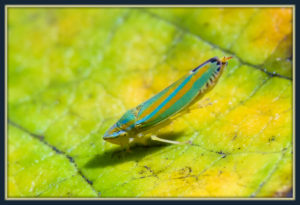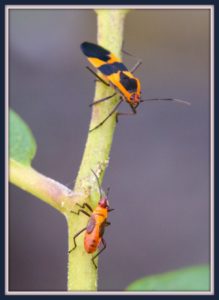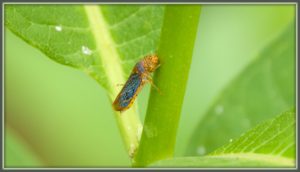Milkweed Monday
Double-click on any image to view it full size. Click the back-button to return to your place on this page.
Greetings!
And an especial welcome to new “subscribers”!
For many people, milkweed is synonymous with Monarch butterflies. However, milkweed can play host to a wide variety of highly colorful insects, just a few of which are featured in this week’s essay. I seem to be acquiring a reputation – at least within the community – as the person to go to if you have a bug to identify! I have no formal qualifications in this area (or in any other wildlife area), but I do like to find new creatures to photograph, and then to identify them using mainly books and the web. And searching for a particular specimen inevitably exposes me to pictures of other species, some of which then become species I hope to add to my photographic collection. One such “wish list” species was the Scarlet-and-Green Leafhopper, which appears in many books and lists. Its size is usually listed as just under half-an-inch long. But the one I finally found this past Saturday was only half that size, and when I first saw this tiny speck on a milkweed leaf I did not recognize it. It was only when I zoomed-in on my first picture of it that I realized what it was. I then spent several minutes trying to get the best possible shot without actually disturbing the creature. My best two pictures are shown as image 1

and image 2.

Many sources simply say “Scarlet-and Green Leafhopper – Graphocephela coccinea“, but it turns out that there are several species within the Graphocephela genus, all of which go by the same common name (or one of its aliases such as the Candy-striped Leafhopper or Red-striped Leafhopper), and I am not totally convinced that my specimen is truly a G. coccinea, but it fulfilled my goal!
The next two images, 3 & 4, are of a Milkweed Tussock moth caterpillar.


Euchaetes egle are also known as the Milkweed Tiger moth, or simply “the other milkweed caterpillar”. It is a bit difficult to tell which end of the caterpillar is which, but I think that in these pictures the head end is towards the bottom of the picture, as the creature munches on the cut edge of the leaf.
Another brightly colored insect commonly found on milkweed is the Large Milkweed Bug, Oncopeltus fasciatus. Picture #5 shows an adult (at the top) and a nymph (juvenile) (at the bottom).

On the nymph you can easily see the dark wing buds. #6 is another view of an adult, in this case in the act of spreading its wings.

This picture also clearly shows the long “beak” – specialized mouth parts of true bugs – which it uses to pierce and suck juices from plants. (Don’t be confused by the rear leg which this specimen is extending rearwards.) When not in use the beak is usually folded beneath its body.
Picture #7 is a Red Milkweed Beetle, Tetraopes tetrophthalmus.

It owes its Latin name to having four eyes. In many longhorn beetles, of which this is one, have the bases of their antennae located very close to their (two) compound eyes. In the case of the Red Milkweed Beetle, the base of the antennae completely bisect the eyes – hence four eyes! Like many of the other insects that eat milkweed, including Monarch caterpillars, this beetle concentrates the cardiac glycosides from the milkweed in its body, making it poisonous to many potential predators, and then advertises its poisonous nature by bright coloration. This is an example of Mullerian mimicry, whereby a noxious species avoids being predated upon because it has evolved coloration that the potential predators have learned to avoid from unpleasant experiences with other similarly colored prey. This is not the same as Batesian mimicry, in which a non-poisonous species has evolved to look like a noxious species, and hence is less likely to be gobbled-up!
The final picture, #8, is a Broad-headed Sharpshooter, Oncometopia orbona.

Like our first insect in this essay, O. orbona is a Leafhopper. The term “sharpshooter” can be used for both species (and others), and while the origin of the term is unclear, it may well be because they can forcibly eject, from the rear of their bodies, excess liquids they have ingested!
And with that thought I will sign-off, wishing you clear skies for the eclipse and, above all, safe viewing!
Have a great week